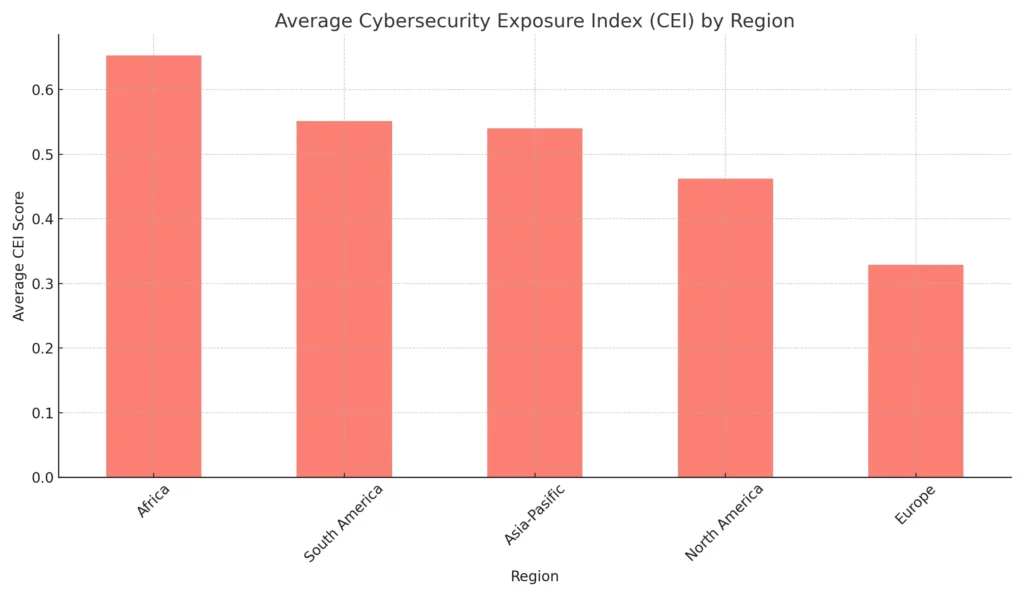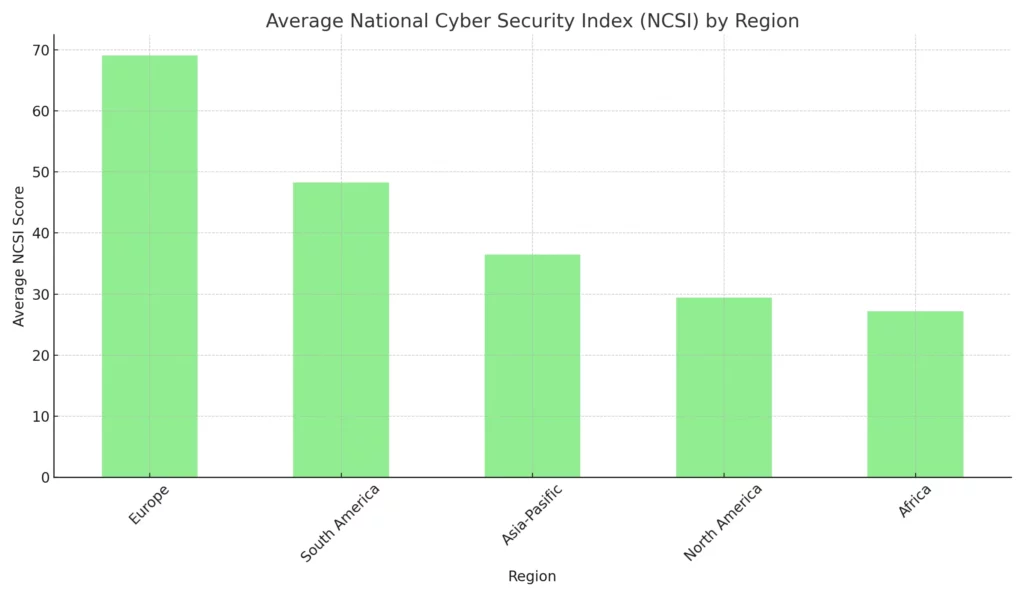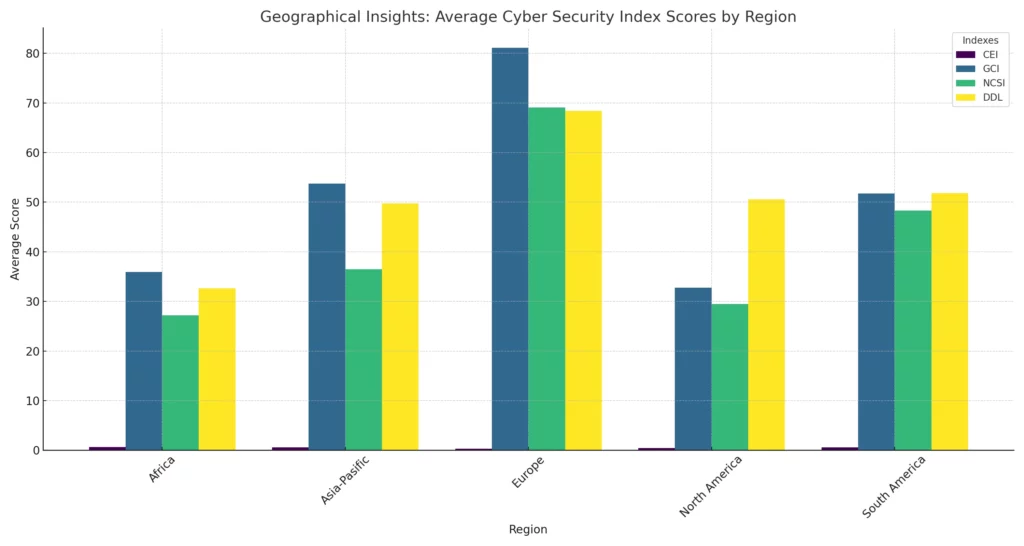Physical Address
304 North Cardinal St.
Dorchester Center, MA 02124
Physical Address
304 North Cardinal St.
Dorchester Center, MA 02124

In today’s digital-first world, understanding our global cyber terrain is more crucial than ever. 2023 has ushered in new challenges, and with them, emerging trends in the Cyber Security Landscape.
Whether you’re a tech enthusiast, a policymaker, or just a curious soul, this deep dive into the latest data will unveil insights that are both alarming and enlightening.
Journey with us as we navigate through intricate indexes, regional vulnerabilities, and the digital strides countries are making. Let’s decode the cyberworld of 2023 together.
In an age where our lives are intricately intertwined with technology, the significance of cyber security cannot be overstated. Every click, every share, and every online transaction carries potential risks.
With cyber threats evolving rapidly, safeguarding our digital realm has transcended beyond mere convenience—it’s now a necessity. As we embrace the digital, understanding and fortifying against these unseen dangers becomes our collective responsibility.
Grasping the nuances of global cyber security can seem daunting. Enter the Cyber Security Indexes—a set of key indicators that shed light on our digital strengths and vulnerabilities.
From gauging exposure to cybercrime with the CEI to measuring a nation’s readiness with the NCSI, these indexes offer invaluable insights. Coupled with the GCI’s assessment of commitment and the DDL’s look at digital progress, we’re granted a holistic view of the cyber world’s pulse.
Diving deeper into the cyber realm, we encounter pivotal metrics that help decode the intricate web of digital security. These are not just numbers but narratives—stories of exposure, commitment, readiness, and digital evolution.
Each index, whether it’s CEI’s exposure lens or GCI’s global commitment gauge, provides a unique perspective, painting a fuller picture of our global digital fortress. Join us as we unravel the layers of these vital cyber security indexes.

In the vast expanse of the digital universe, the Cybersecurity Exposure Index serves as our compass, pointing out the regions most vulnerable to cyber threats. It’s not just an index—it’s a mirror reflecting our online exposures, from the most shielded sanctuaries to the risk-prone territories.
A higher score isn’t a badge of honor; it’s a clarion call for increased vigilance. So, where does your region stand in the Cybersecurity Exposure Index’s revealing light?

In a digital age defined by data breaches and cyberattacks, the Global Cyber Security Index emerges as a beacon, highlighting where nations stand in their commitment to cyber safety.
This index isn’t just about numbers—it’s a testament to how fervently countries are bolstering their digital walls, aiming to shield their citizens from lurking cyber threats. But how robust is this global resolve? Dive in as we explore the pulse of global commitment to cybersecurity.

In a world riddled with cyber uncertainties, the National Cyber Security Index emerges as a barometer of national readiness. It’s more than an index—it’s a narrative of how equipped nations are to confront digital demons.
From data fortresses to response strategies, the National Cyber Security Index encapsulates a nation’s cyber arsenal. Curious about who’s leading the defense and who’s catching up? Let’s delve into this crucial metric of cyber preparedness.

As the world hurtles toward a digital future, the Digital Development Level stands as a testament to how nations are evolving in this digital race. It’s not merely an index—it’s a story of innovation, adaptation, and the strides countries are making in the digital realm.
But who’s truly harnessing the digital wave, and who’s still testing the waters? Journey with us as we chart the global digital development landscape.

Digital landscapes vary as much as physical terrains do. From the bustling tech hubs of Europe to the emerging digital frontiers in Africa, cyber security paints a diverse picture continent-wise. It’s a tale of varied challenges, unique vulnerabilities, and distinct commitments.
So, what does cyber security look like across different geographical bounds? Embark on a journey with us as we traverse the cyber security terrains of our world.
Asia-Pacific, a dynamic mix of burgeoning tech giants and emerging digital players, presents a multifaceted cyber tableau. While nations like Japan and Singapore showcase robust digital defenses, others are still navigating the labyrinth of cyber threats.
But it’s not just about the disparities—it’s about the shared aspirations and collective challenges. Dive into an exploration of how this vibrant region grapples with cyber risks while marching forward in the digital era.
Europe, with its rich tapestry of history and innovation, stands at a unique crossroads in the realm of cyber defense. Balancing a legacy of esteemed institutions with a thirst for digital advancement, its nations strive to fortify their cyber frontiers.
But where does Europe truly stand amid the global cyber cacophony? Are its fortresses impenetrable, or are there chinks in the armor? Join us as we explore Europe’s dedication and resolve in the face of the ever-evolving digital threat landscape.
In the vast expanse of Africa, a digital revolution is quietly unfolding. From bustling tech hubs in Nairobi to innovation centers in Johannesburg, there’s a fervent drive to bridge the cyber security gap. While challenges abound, the spirit of resilience shines through.
But how well-prepared is Africa in its defense against cyber adversaries? As the continent leaps into a connected future, join us in understanding its journey to ensure a safer digital tomorrow.
North America, a titan in the digital realm, boasts robust cyber defenses. But with great power comes great responsibility—and greater threats. From Silicon Valley’s tech giants to the bustling cities of the East Coast, the region’s cyber landscape is both its strength and its Achilles’ heel.
As cyber adversaries evolve, how fortified is North America’s digital fortress? Dive deep with us as we explore the strengths and vulnerabilities of this cyber powerhouse.
South America, with its rich tapestry of cultures and landscapes, is rapidly embracing the digital age. As cities like São Paulo and Buenos Aires surge ahead as tech hubs, the continent grapples with securing its burgeoning digital footprint.
But beyond the challenges lie opportunities and a vision for a digitally secure future. Embark with us on an exploration of South America’s evolving cyber landscape and its quest for digital security.

In the intricate web of cyber metrics, understanding how indexes interplay can be enlightening. While each index stands tall with its unique story, its interactions weave a broader narrative of global cyber dynamics.
Do countries with high exposure also show greater readiness? Is digital growth directly linked to cyber commitment? Let’s untangle these threads and uncover the correlations that define our global cyber landscape.
In today’s hyper-connected world, where the internet knits together every facet of our lives, the specter of cyber threats—like malware, ransomware, and phishing—looms larger than ever. The United States and other big countries, with its vast digital expanse, remain vigilant against these risks.
However, as the Internet of Things (IoT) expands its reach, the cyber threat landscape becomes more intricate. Passwords, once a simple shield, now demand more layers of security. Risk management isn’t just a corporate term; it’s a global necessity.
From combating advanced malware to educating the masses about phishing pitfalls, the path forward is clear: a united front in fortifying our digital domains. As we stand on the cusp of a new digital era, strengthening global cyber security isn’t just a goal—it’s an imperative.
In the vast expanse of the internet, where ransomware and malware lurk behind every corner, the collective action of policymakers, corporations, and individuals becomes paramount. Policymakers, not just in the United States but globally, need to draft stringent guidelines to counter the ever-evolving cyber threat landscape.
Corporations, on the other hand, have a dual role: protecting their vast reservoirs of data while ensuring credentials and passwords remain impenetrable. As the Internet of Things (IoT) expands, the risk magnifies.
Macros in innocent-looking documents can trigger a cascade of phishing and social engineering attacks. Places like Russia have become noteworthy in the cybersecurity discourse.
Individuals, armed with knowledge, can thwart these threats at the grassroots—simple acts like double-checking URLs and updating passwords regularly make a difference. Together, we can carve a safer digital future.